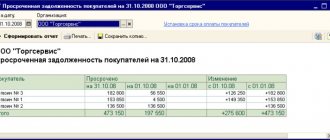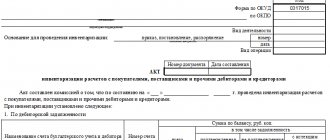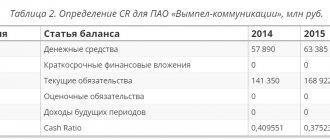What does the accounts receivable turnover ratio show?
The accounts receivable turnover ratio has the abbreviation (Kob.dz) and shows how many times during the reporting period (month, quarter, year) the accounts receivables have turned over in the company. This coefficient shows the effectiveness of using receivables for enterprises; also in some educational publications, this coefficient is proposed to be used as an indicator of receivables
management
Receivables repayment period: what is this indicator
Accounts receivable at the beginning of the period – 585,000 rubles;
Accounts receivable at the end of the period – 560,000 rubles;
Sales revenue for two months of the billing period amounted to 1,100,000 rubles.
((585,000,560,000) / 2) / 1,100,000 x 6 / 365 = 572,500 / 18,082 = 31.7 days.
To calculate the repayment period of receivables, we multiply sales revenue by 6, since for the calculation we need revenue indicators for only two months, but we need annual ones.
We compare the resulting indicator with the established deferred payment period and conclude that the company has an acceptable accounts receivable turnover period of 31.7 days.
ODZ = V / ((DZn DZk) / 2), where
B – revenue;
DZn – accounts receivable at the beginning of the period;
DZk – accounts receivable at the end of the period.
In order to analyze the indicator for DZ, the calculation is made for several periods of time. This is done so that it can be determined whether this indicator is growing or decreasing, and, accordingly, drawing conclusions on the financial condition of the company at the end of the year.
Kodz = page 2110 / ((page 1230 at the beginning p. 1230 at the end) / 2)
| ★ Best-selling book “Accounting from scratch” for dummies (understand how to do accounting in 72 hours) purchased by {amp}gt; 8000 books |
https://www.youtube.com/watch?v=ytdevru
The concept of “accounts receivable” is used in cases where we are talking about the obligations of individuals and legal entities to the analyzed business entity (the debts of counterparties, clients and other persons will be listed in its balance sheet as “receivables”). Let’s say that an enterprise has completed production of a product and delivered it to the warehouse of a counterparty-customer, but the buyer has not yet paid money for the product.
As you can understand, accounts receivable reflected in the financial statements do not always guarantee the receipt of money. It may end up being uncollectible. This happens if the debtor goes bankrupt or liquidates a legal entity. In this regard, any lending implies the occurrence of a certain credit risk (the probability of non-receipt of money). This risk can be reduced by first assessing the liquidity and financial strength of the borrower.
The repayment period for receivables is an indicator of the effectiveness of commercial relations with the enterprise's borrowers (consumers, partners). This indicator demonstrates how long a business entity has to wait for counterparties to fulfill their obligations towards it. It can also be said that the repayment period of receivables shows the degree of payment discipline of the consumer.
Let’s say the company’s managers have approved a deadline for commodity lending (selling goods “on credit”) equal to 14 calendar days. This means that the repayment period for receivables must be either less than or equal to 14 days. If the indicator is lower, this will not affect the activities of the product manufacturer. If the indicator value is higher, it means that debtors are late in payments and may become insolvent.
| Index | Agriculture | Food industry (processing) | Wholesalers/retailers (intermediaries) | Other areas of activity |
| Receivables repayment period | No more than 75 days | No more than 45 days | No more than 30 days | No more than 30 days |
Now we give general recommendations for approving standard values for the receivables repayment period indicator in companies:
- In order to draw clear conclusions about establishing the standard for repayment of receivables, their quality should be analyzed. Next, you will need to find out what the profit would be if the funds that the buyer of the goods “owed” for the delivery were placed on a bank deposit. It is also imperative to estimate the amount of interest payments for the use of credit funds taken to finance receivables. Finally, both results obtained must be compared with the size of the increase in profit obtained through the sale of products on credit.
- Consideration of the dynamics of the indicator will also have a positive impact on management decisions. If the value decreases, it means that buyers are diverting the firm's cash for a shorter period of time. It would seem that the shorter the finances are diverted for, the better. However, for companies for which commodity lending is part of their marketing strategy, an increase in accounts receivable is beneficial, since this leads to an increase in sales.
- In addition, in external and internal analysis, it is very useful to compare the performance of the period of receivables with similar sized enterprises (you can select companies for comparison with similar asset values).
If the obtained value of the repayment period is exceeded by the debtor, the liquidity of the company may suffer. Moreover, the longer the payment period the seller sets, the greater the likelihood that he will ultimately not receive his money from the buyer.
In order not to encounter insolvent counterparties and fly-by-night companies that ultimately will not pay off receivables, you should pay attention to the text of Order of the Federal Tax Service of Russia dated May 20, 2007 No. MM-3-06 / [email protected] - it proposes a list of main criteria , which can be used to determine whether it is worth releasing goods to the buyer on credit. These include, for example, the availability of information about a potential counterparty in the Unified State Register of Legal Entities, the fact of registration at a “mass” legal address, etc.
In addition, thanks to the decision of the tax service, the average number of employees, the amount of income/expenses on the balance sheet, the amount of taxes paid to the budget, the amount of arrears (if any) on fines and penalties, and the fact of tax violations became publicly available information. Finding out this data will allow you to assess the degree of reliability of a potential debtor.
If the company’s resources allow for comprehensive work with current and potential customers, it is advisable to take the following actions:
- assemble a specialized group of “appraisers” whose task will be to collect information about a potential counterparty before concluding an agreement with him;
- regularly monitor data on debtors with whom a contract has already been concluded (analyze financial statements, check for the presence of court cases involving them);
- develop regulations for cooperation with debtors.
Even if an agreement with the buyer has been concluded, and work with the counterparty has been going on for quite a long time, the terms of cooperation and the possibility of continuing supplies on credit in principle should be regularly reviewed. To do this, the following indicators are assessed on a 100-point scale:
- duration of cooperation with the company;
- average volumes of supplies to a given counterparty;
- financial performance indicators reporting;
- the amount of overdue debts and the period of delay;
- values of receivables turnover ratios;
- forecast indicators (commodity market conditions).
If the counterparty scores less than 50 points, you should cooperate with him only on condition of 100% prepayment for the delivery. If the points are more than 50, but less than 70, it is necessary to require partial prepayment, limit the period of debt and the amount of debt, and strictly monitor the timing of payment of receivables. If the points are more than 70, the counterparty is reliable, and the contract can be drawn up on standard terms and even with privileges.
If during the analysis it turns out that the enterprise’s indicators of the receivables repayment period turned out to be significantly less/more than the identified standard values, it is necessary to take this indicator under control. To do this, you will need to develop an entire strategy that includes the following points:
- approval of the markup on products sold on credit (trade credit), i.e. essentially selling goods at a higher price for the possibility of deferred payment;
- levying a fine for late payment obligations;
- development of a work plan in case of delays;
- assessment of the solvency and financial stability of buyers in order to identify those clients to whom it is permissible to sell products on credit.
| The most competent method of calculation (more reliable results are obtained) | (8) |
| In the case when the analyst knows only data at the end of each month of the analyzed period | (9) |
| If only annual data is available | (10) |
Below is a list of recommendations and comments for those who are interested in the most accurate results of calculations of the receivables repayment period:
- When making calculations, it is impossible to take into account the amounts of receivables that were not formed as a result of the supply of products (services, works) of the company under study on credit. The calculations should include only receivables arising from the supply of goods and services to the company’s customers on credit.
- If an enterprise in its activities is guided by an ordinary business year (January-December), or there is a significant influence of seasonal factors, the value of the receivables repayment period indicator may be misleading (usually lower than actual) due to the fact that at the end of the year it could low-quality overdue receivables may be written off, and at the end of the year the actual number of sales will be less than the average sales volume during the period. To prevent this from interfering with the calculations, it is better to use formulas that would require an external analyst to use daily or monthly data (not annual data).
- Of course, it is recommended to provide the external analyst with as much internal documentation as possible - this will make it easier for him to find out the reason for the increase/decrease in the value of the receivables repayment period.
Formula for calculating the accounts receivable turnover ratio
The accounts receivable turnover ratio is the ratio of sales revenue to the company's average annual
There are 2 methods for calculating the turnover of household items, in general they are both almost the same:
- calculation formula based on the balance sheet and financial results report (if there are no line numbers in these forms):
Kob.dz = Revenue (V) / Average annual value of accounts receivable (DZ)
- calculation formula based on the lines of the balance sheet and the income statement:
Kob.dz = line 2110 (financial res. report) / (line 1230 at the beginning of the “BB” period + line 1230 at the end of the “BB” period) / 2
The accounts receivable turnover ratio is always calculated using the average annual value of accounts receivable, i.e. (dz beginning + dz end)/2 , the calculation based on the balances of accounts receivable at the end of the period is NOT correct!!!
Here is an example of calculating the accounts receivable turnover ratio
An example of receivables turnover analysis
The concept of accounts receivable
All companies take into account remote assets, since it is impossible to do without this asset. It arises due to the mutual interest of the company offering its services/products and the consumer of these goods - enterprises and individuals. The agreements concluded between them often become mutually beneficial: the manufacturer finds markets by supplying goods by agreement without advance payment, with subsequent installment payments, and the buyer is given the right to use the purchased product without payment for a certain time. This is how a remote payment arises, the size of which is determined by the monetary equivalent of future receipts. In the balance sheet, this asset is reflected on line 1230.
In addition, advances to supplier enterprises for subsequently purchased goods are also included in the purchase order. Transactions with deferred payments are always associated with serious risks, and therefore are very carefully controlled.
What does a change in the accounts receivable turnover ratio mean?
A decrease in turnover means a slowdown in accounts receivable turnover, which negatively affects the activity of the enterprise, because Accounts receivables turn over slowly and debts from customers are returned with delays.
An increase in cash flow turnover means that the enterprise operates more rhythmically, its receivables turn over more quickly, a rapid exchange of cash flows occurs, and therefore the enterprise operates more rhythmically.









